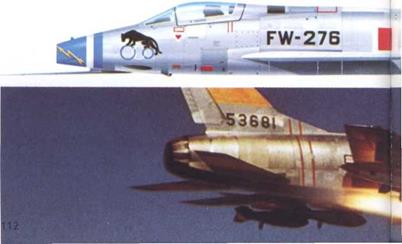North American (Rockwell) F-100 Super Sabre
F-100A to F-100F and DF-100F
Origin: North American Aviation Inc. Inglewood, USA.
Type: Single-seat fighter-bomber: (F-100F) two-seat operational trainer: (DF) missile or RPV director aircraft.
Engine: One Pratt & Whitney J57 two-shaft turbojet with afterburner, (most blocks of A) 14,5001b (6576kg) J57-7: (late A, all C) 16,0001b (7257kg) J57-29: (D, F) 16,9501b (7690kg) J57-21A (all ratings with afterburner).
Dimensions: Span (original A) 36ft 7in: (remainder) 38ft 9iin (11 81m): length (except F, excluding pitot boom) 49ft 6in (15 09m), (fuselage, 47ft exactly): (F) 52ft 6in (16 0m), (boom adds about 6ft to all models); height (original A) 13ft 4in; (remainder) 16ft 2Jin (4-96m).
Weights: Empty (original A) 19,7001b; (C) 20,4501b; (D) 21,0001b (9525kg); (F) 22,3001b (10,11 5kg); maximum loaded (original A) 28.935lb; (C, D) 34,832lb (15,800kg); (F, two tanks but no weapons) 30.700lb (13,925kg).
Performance: Maximum speed (typical of all) 864mph at height (1390 km/h, Mach 1-31); initial climb (clean) 16.000ft (4900m)/min; service ceiling (typical) 45.000ft (13.720m); range (high, two 375gal tanks) 1,500 miles (2415km).
Armament: Usually four (F, only two) 20mm M-39E cannon each with 200 rounds; (A) pylons for two 375gal supersonic tanks and four additional hardpoints (seldom used) for 4,0001b ordnance; (C, D) two tanks and six pylons for 7,5001b (3402kg) ordnance: (F) two tanks and maximum of 6,0001b (2722kg) ordnance.
History: First flight (YF-100) 25 May 1953; production (A) 29 October 1953; final delivery October 1959.
Users: Denmark, Taiwan, Turkey.
 |
Development: The success of the Sabre made it natural to attempt a successor, and in February 1949 this was planned as a larger and much more powerful machine able to exceed the speed of sound in level flight (had it been started two years later it might have been smaller, in view of the Korean pressure for simple fighters with the highest possible climb and performance at extreme altitudes). Unusual features were the 6 per cent wing with 45“ sweep, no flaps, inboard ailerons, full-span slats a. nd a slab
tailplane mounted as low as possible. Level supersonic speed was achieved, for the first time with a combat aircraft, but after very rapid development, with the first (479th) wing fully equipped, the F-100A was grounded in November 1954. Trouble due to inertia coupling between the roll and yaw axes necessitated urgent modification, the wings and fin being lengthened. Subsequently the career of the "Hun" was wholly successful, the 203 A fighters being followed by the stronger C fighter-bomber, the D with flaps and autopilot and the tandem-seat F. Total production was lower than expected at 2,294, many being built by NAA’s newly occupied factory at Columbus, Ohio. In their early years the later versions pioneered global deployment of tactical aircraft by means of probe/drogue refuelling, and in Vietnam they proved outstandingly good at both low attack and top cover, flying more missions than over 15,000 Mustangs flew in World War II. In 1977 the survivors of what two decades earlier had been among the world’s elite warplanes were in their final months of combat duty after countless inspection, repair and modification programmes.
![]()
![]()

![]()
 Left: Turkey is one of the last nations to retain a force of F-100 Super Sabres: this is an F-100D-15 single-seat ground-attack aircraft.
Left: Turkey is one of the last nations to retain a force of F-100 Super Sabres: this is an F-100D-15 single-seat ground-attack aircraft.
Below: At one time the USAF operated the GAM-83 (later restyled AGM-12) Bullpup command-guided air-to-surface missile from the F-100, though it was withdrawn before the aircraft itself (which remained in service after the war in Vietnam).










